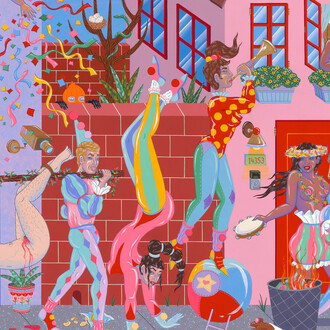Harkawik is pleased to announce Single Landscapes, our eighth collaboration with painter John Seal. Here Seal eschews the multiple registers and elaborate framing devices with which we have become familiar, collapsing his concerns into a single large landscape format, and presenting his chosen subject with a powerful consistency and concision.
Seal’s project is heavily invested in a sociological examination of the role of the artist in society, and a recapitulation of the conditions of creative and intellectual practice; here this examination occurs paradoxically in the simple act of creation, and in the sacrosanct encounter we may have with its product. What’s at issue here is encoded exclusively in the very specific execution of the painting itself—in its buttery skies, slightly impasto foliage, in the long cleaved marks that delineate broken wood or stalks sprouting from the earth toward the sun. It is precisely because Seal’s ambition lies beyond the creation of pictures that there’s so much to find within them.
In each of the exhibition’s eight identically-sized canvases, we observe a moment in the wilderness, a distinct setting and time of day. These are the result of Seal’s visits to sites ravaged by wildfire, and his titles reveal them. If climate science is by definition urgent, its facticity is absent here, and in its place, we are given to know a kind of modern beauty, found at the intersection of various shocking upheavals. Charmlee Wilderness Park 1 adopts a low angle as if Seal is specifically calling out the cinematic properties of the work.
Sierra National Forest 1 and Sierra National Forest 3 both offer vistas that might recall the Hudson River School were it not for the visible acres of blackened stumps. Shasta Trinity National Forest 3 and Sierra National Forest 2 call to mind the golden era of the National Parks, when private cabins on these lands were sold via ads in the back of Popular Mechanics. On close inspection, features in them retain an approximated, slightly cartoonish look, as if Seal is uncomfortable with us seeing any one particular shrub, any specific branch, rather than its universal.
A central tree stump appears as a sort of character in the foreground of several paintings. In Shasta-Trinity National Forest 2, this figure sits perched on the edge of a sandy hill, peering out just beyond our vantage point, grasping to the hillside despite evident erosion and the misfortune of being severed at the waist. In Charmlee Wilderness Park 2, the “character” is oddly reminiscent of Charles Ray’s 2010 sculpture, Log.
As the story goes, Ray was driving up a stretch of the Pacific Coast Highway when he encountered an unusually compelling log. He brought it back to the studio, made molds, had it cast in plastic, and then sent it to Japan to be carved from cypress. What appears at first to be a masochistic or pedantic endeavor reveals itself as a sublimely pure act of artistic creation—a “delayed reproduction,” that enables us to see something like what we see when we encounter the natural world itself. We need to see ourselves seeing nature to know anything about that sort of encounter.
Seal gives us precisely what he needs us to see, and yet his paintings don’t show us the natural world, whether it’s the specific one encountered on a solitary walk, or abstract, gigantic, sublime imponderable nature, nor do they record him, or us, or anyone else perceiving it. They are Schrödinger’s cats.
In each picture, we see simultaneously two possible realities. In the first, the scarred earth has begun to heal itself, to regenerate foliage, and to welcome back its native species and human interlopers. Here, charred remains of wildfire offer a fertile basis for healthy regeneration. In the second, we witness continued and increasingly severe cycles of devastation, from which there can be no escape. In this reality, the presence of a single shiny black stump is menacing, a disquieting stain on an otherwise idyllic setting, and insistent evidence that there is no place on Earth safe from the terrible impact of human endeavors. Crucially, Seal’s paintings take no “position.” Like the inevitable shifts they encode, they simply are.















